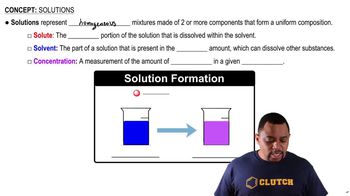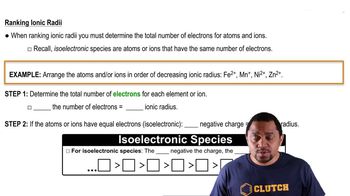Indicate the type of solute–solvent interaction (Section 11.2) that should be most important in each of the following solutions: (c) KBr in water
Ch.13 - Properties of Solutions
Chapter 13, Problem 16b
Indicate the principal type of solute–solvent interaction in each of the following solutions and rank the solutions from weakest to strongest solute–solvent interaction: (b) CH2Cl2 in benzene (C6H6)
 Verified step by step guidance
Verified step by step guidance1
Identify the types of molecules involved in the solution: CH2Cl2 (dichloromethane) and C6H6 (benzene).
Determine the polarity of each molecule: CH2Cl2 is a polar molecule due to the electronegativity difference between carbon and chlorine, while benzene is a nonpolar molecule.
Analyze the type of interaction between the solute (CH2Cl2) and the solvent (benzene): The primary interaction is likely to be dipole-induced dipole interaction, where the permanent dipole of CH2Cl2 induces a temporary dipole in the nonpolar benzene molecules.
Consider the strength of the interaction: Dipole-induced dipole interactions are generally weaker than hydrogen bonding but stronger than London dispersion forces.
Rank the interaction strength: Since this solution involves dipole-induced dipole interactions, it would be ranked as having a moderate strength of solute-solvent interaction compared to other types of interactions like ion-dipole or hydrogen bonding.

Verified video answer for a similar problem:
This video solution was recommended by our tutors as helpful for the problem above.
Video duration:
1mWas this helpful?
Key Concepts
Here are the essential concepts you must grasp in order to answer the question correctly.
Solute-Solvent Interactions
Solute-solvent interactions refer to the forces that occur between solute particles and solvent molecules when a solution is formed. These interactions can include hydrogen bonding, dipole-dipole interactions, and London dispersion forces. The strength and type of these interactions significantly influence the solubility of a solute in a solvent.
Recommended video:
Guided course

Solution Components
Polarity
Polarity is a key concept in chemistry that describes the distribution of electrical charge over the atoms in a molecule. Polar molecules have a significant difference in electronegativity between their atoms, leading to partial positive and negative charges. In the context of solute-solvent interactions, polar solutes tend to dissolve well in polar solvents, while nonpolar solutes dissolve better in nonpolar solvents.
Recommended video:
Guided course

Molecular Polarity
Ranking of Interactions
Ranking solute-solvent interactions involves comparing the strength of different types of intermolecular forces present in a solution. Generally, hydrogen bonds are the strongest, followed by dipole-dipole interactions, and then London dispersion forces. Understanding this hierarchy helps in predicting the behavior of solutions and their properties, such as boiling and melting points.
Recommended video:
Guided course

Ranking Ionic Radii
Related Practice
Textbook Question
Textbook Question
Indicate the type of solute–solvent interaction (Section 11.2) that should be most important in each of the following solutions: (d) HCl in acetonitrile (CH3CN)
Textbook Question
Indicate the principal type of solute–solvent interaction in each of the following solutions and rank the solutions from weakest to strongest solute–solvent interaction: (a) KCl in water
Textbook Question
Indicate the principal type of solute–solvent interaction in each of the following solutions and rank the solutions from weakest to strongest solute–solvent interaction: (c) methanol (CH3OH) in water
1
views
Textbook Question
An ionic compound has a very negative ∆Hsoln in water (b) Which term would you expect to be the largest negative number: ∆Hsolvent, ∆Hsolute, or ∆Hmix?
